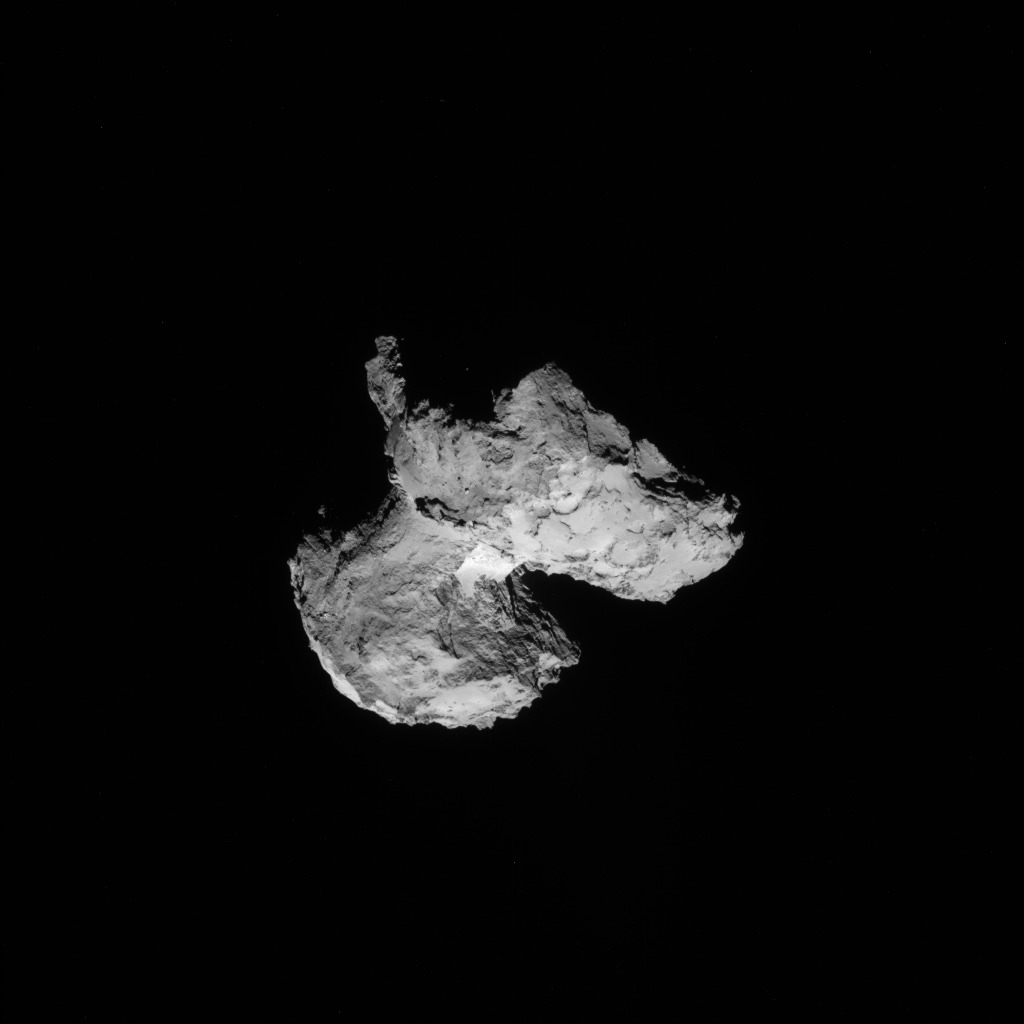Rosetta navigation camera (NAVCAM) image taken on 12 August 2014 from about 103 km from comet 67P/C-G.
CometWatch – 12 August
- access_time 13/08/2014
- chat_bubble_outline 13 comments
Written by
emily
access_time
13 August 2014
chat_bubble_outline
13 comments
format_list_bulleted
Ambition the film

Click image to watch Ambition
Read Rosetta: the ambition to turn science fiction into science fact
Mission milestones
| Event | Date |
| Launch | 2 Mar 2004 |
| Earth swingby | 4 Mar 2005 |
| Mars swingby | 25 Feb 2007 |
| ... more | |









Discussion: 13 comments
I see patchy whiter higher albedo spots on the “bottom/underneath chin of the duck’s head” areas, looks like snowfield on mountain. can Alice or Virtus “see” the white areas?
Also would be worth seeing with the OSIRIS NAC, to see the finer structure of the area under the ‘chin’
This is the first decent view I think we have seen unger the ‘chin’ so far. Looks like there is a tiny crater there too.
This is a fantastic image however, lots to talk about here for sure.
When can we see pictures with the REAL camera, not the navigational camera?
Because the science teams that worked years and invested a huge amount of time, resources and competences have the priority on the science data analysis, for I guess a year or so. Frustrating for us but understandable.
Hi Emily–
The daily images are much appreciated, but it is difficult to discern how they relate to one another because the viewing angle and illumination change so much. Perhaps you could provide the sub-spacecraft longitude and latitude for each image. We would then be able to tell the viewing angle relative to the equator of rotation and rotation angle.
–Richard
Another fantastic NavCam release.
This is the first good look at the ‘chin’ area under the smaller lobe in these releases. A lot of structure is visible, generally striations from the ‘neck’ area and there is a tiny crater.
That ‘neck’ is really thick, I suspect there will be no fragmentation any time soon.
I think we can dispose of the idea of a contact binary, rather this is one object ‘sculpted’ by impacts and solar radiation.
Mystery is though, 67P/Churyumov-Gerasimenko has only been coming close enough to the Sun at perihelion for sublimation since 1959. Yet the comet looks more weathered than that. Wonder if in the distant past 67P/Churyumov-Gerasimenko did at one time have closer perihelia, than the orbit expanded before becoming smaller again?
What an impact
in the upper side of this photo!
https://www.esa.int/spaceinimages/Images/2014/08/Comet_on_12_August_2014_-_NavCam
I dont think these are impacts, take a close look, some are hexagon shaped craters, Some of the smaller ones, are 2 or 3 times deeper than the diameter with vertical sides, some of these appear to be made in pairs. These shapes surely can not be made by an impact.
I can definitely see a mouse in the top left, it appears to be studying a frog like creature to the left of the snow patch.
It is the most wonderful thing to be able to witness this whole drama unfolding before us. Thank you so much.
The neck goes along
the “layering”.
A model could be that
the neck is made of less dense layers.
So the bigger sun ablation.
If ‘layering’ turns right
then 67P is just a chip of something.
What I wonder is: Will the composition be relatively uniform, or does it have a harder core and fluffy material around?
Also, are the brighter-looking areas bright because the darker material was removed recently (say by impact or outgassing), or because some previously-sublimated water settled back there when it last went to aphelion? Or were they just painted that way to make it look nicer?
See here: https://i.imgur.com/emq61FW.jpg
I’m wondering about this central part of the picture. It really looks like a landslide doesn’t it? How can this be in a microgravity environment?